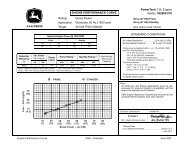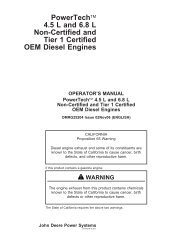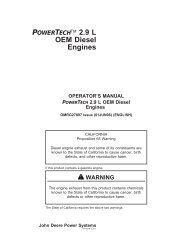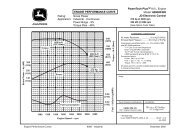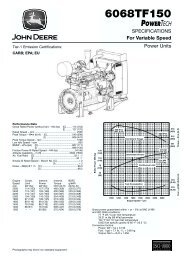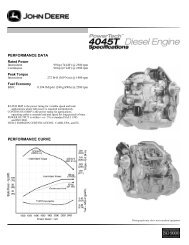A Publication of John Deere Power Systems - John Deere Industrial ...
A Publication of John Deere Power Systems - John Deere Industrial ...
A Publication of John Deere Power Systems - John Deere Industrial ...
- No tags were found...
You also want an ePaper? Increase the reach of your titles
YUMPU automatically turns print PDFs into web optimized ePapers that Google loves.
RELIABILITYPhoto courtesy <strong>of</strong> Kelly Heyn and Jessica SarnakThe GCS 238 refuels acontainer ship with two<strong>John</strong> <strong>Deere</strong>-poweredpumps capable <strong>of</strong>delivering 1.2 millionliters <strong>of</strong> fuel per hour(324,000 gph).A Consistent Flow <strong>of</strong> ReliabilityGellatly & Criscione choose EPA marine-certified <strong>John</strong> <strong>Deere</strong>industrial engines for its new fleet <strong>of</strong> ocean-certified fuel bargesLike a floating filling station, the GCS 238barge travels between major port cities on theAtlantic coast in search for fuel-thirsty passengerliners and container ships bound for transatlanticvoyages. Within the 91-meter (300 ft.),double-hulled vessel are some 6,200 cubicmeters (39,000 U.S. barrels) <strong>of</strong> fuel valued atroughly $3.3 million (U.S.). That’s a lot <strong>of</strong> fuel,and some ships will consume every bit <strong>of</strong> itbefore journeying out into the broad Atlantic.Fast, reliable, and efficient pumping is a mustto move that much fuel and to avoid steepdemurrage rates <strong>of</strong> $2,500 per hour if a ship isdelayed. With an excellent track record, theGCS 238 pumps a whopping 1.2 million liters<strong>of</strong> fuel per hour (324,000 gph). Aboard thisocean-certified barge are two Byron Jacksoncentrifugal pumps each powered by its own<strong>John</strong> <strong>Deere</strong> <strong>Power</strong>Tech 6125H industrialengine. The Environmental Protection Agencyhas certified the <strong>John</strong> <strong>Deere</strong> <strong>Power</strong>Tech 12.5Lindustrial engines for use in marine auxiliarycommercial applications (see note at right).Lots <strong>of</strong> forethought. Barge owners AlexGellatly and Mario Criscione, who own andoperate Gellatly & Criscione Services Corp.out <strong>of</strong> New Jersey and New York, chose the<strong>John</strong> <strong>Deere</strong> engines for the new GCS 238 afterextensive research and serious consideration <strong>of</strong>all the competitive engines on the market. “Ichecked with several other people who ran<strong>John</strong> <strong>Deere</strong> engines concerning reliability, andequally important, the network <strong>of</strong> dealers in theNortheast,” says Gellatly. “I received nothingbut great reviews about the engines. And loand behold, <strong>John</strong> <strong>Deere</strong> has a vast network <strong>of</strong>technicians in the field to service them.”Gellatly says the 317-kW (425 hp) engines<strong>of</strong>fer an ample reserve <strong>of</strong> horsepower needed tomaintain a constant rpm, which is so crucial in10 <strong>Power</strong>Sourcekeeping the refueling process running smoothly.“We needed a 15 to 20 percent reserve shouldthere be backpressure or restriction in the line,”explains Gellatly. “We have the reserve powerso it doesn’t bog down.”Electricity. In addition to the <strong>Power</strong>Tech6125H engines, the GCS 238 is fitted with twogenerator sets powered by <strong>Power</strong>Tech 4045Tmarine engines that deliver 60-kW <strong>of</strong> continuoushorsepower. The gen-sets each take turnssupplying the electrical needs to the barge,including the crew’s living quarters, the motordrivenhydraulics, air compressor, navigationequipment, blowers, and mechanical tools.Gellatly says each gen-set, alone, provides acontinuous supply <strong>of</strong> power that’s more thanadequate to run all <strong>of</strong> the barge’s electricalfunctions nonstop throughout the year.“Every one <strong>of</strong> my employees has nothingbut great reviews on the <strong>John</strong> <strong>Deere</strong> engines,”relates Gellatly. “What we need are reliablepumps and pump engines, and <strong>John</strong> <strong>Deere</strong> fitour package perfectly. The engines are smoothand reliable. We haven’t had one incident withthe <strong>John</strong> <strong>Deere</strong> engine where it delayed us orcaused us to find an alternate barge.”Gellatly & Criscione continues to upgradeits fleet with double-hulled vessels with morecapacity and reliability. And Gellatly says healready knows what type <strong>of</strong> power will beaboard these new vessels: <strong>John</strong> <strong>Deere</strong>. “Thepro<strong>of</strong> is in the pudding,” he says. “We lovethem.”Engines: <strong>John</strong> <strong>Deere</strong> <strong>Power</strong>Tech 6125H — a317-kW (425 hp), 6-cylinder, 12.5L, air-to-airaftercooled diesel engine. Dealer: KennedyEngine Co., Biloxi, Miss., (228) 392-2200.Distributor: Engines Inc., Weiner, Ark.,(870) 684-7361, www.enginesinc.com<strong>John</strong> <strong>Deere</strong> industrialengines receive EPAcertification for marineauxiliary commercialapplications<strong>John</strong> <strong>Deere</strong> engines are among thefirst choice for generator and pumpingrequirements in the commercial marineindustry. Several models <strong>of</strong> <strong>John</strong> <strong>Deere</strong>industrial engines are now approved formarine auxiliary applications. Thesemodels include the 187-kW (250 hp)<strong>Power</strong>Tech 6068H, the 242-kW(325 hp) 6081H, the 317-kW (425 hp)6125H, and the 392-kW (525 hp)6125H. A marine auxiliary engine isdefined in 40 CFR Part 94 and clarifiedin EPA documents EPA420-R-05-008,“Test Procedures for Highway andNonroad Engines and Omnibus TechnicalAmendments, Technical SupportDocument and Summary and Analysis<strong>of</strong> Comments” and CSID-06-012“Portable Auxiliary Marine Engines –Interpretation <strong>of</strong> Installed”. In summary,an engine is considered a marine auxiliaryengine if (1) it is tied to the ship’sfuel, cooling, or exhaust systems, or (2)it is mounted on the vessel in such away that requires significant effort toremove it. For example, if a portableengine is designed with a quick-connectaccess to the onboard fuel supply orwith other hardware that allows theengine to tie into the vessel’s coolingor exhaust systems, EPA will considersuch engine installed. Even though it is“portable,” such an engine generallycannot operate without the fueling orother systems available on the vessel.In other words, it cannot be operatedonce it is removed from the vessel. If theinstallation meets the marine auxiliarycriteria, then the engine can be certifiedas a marine auxiliary engine.




